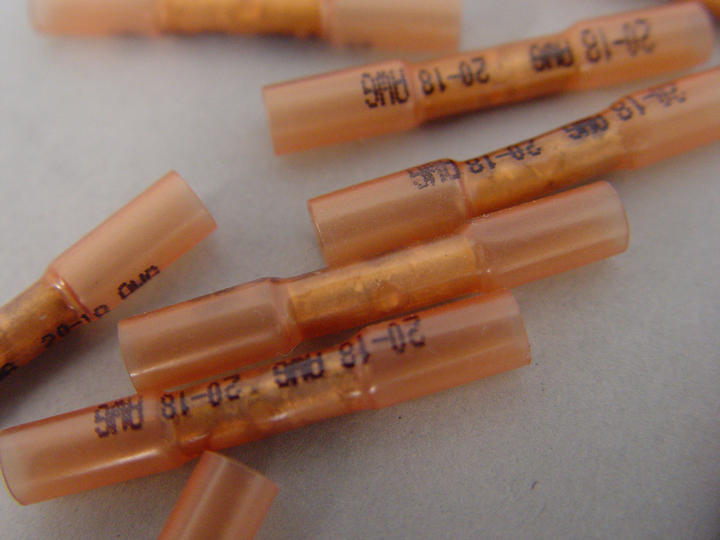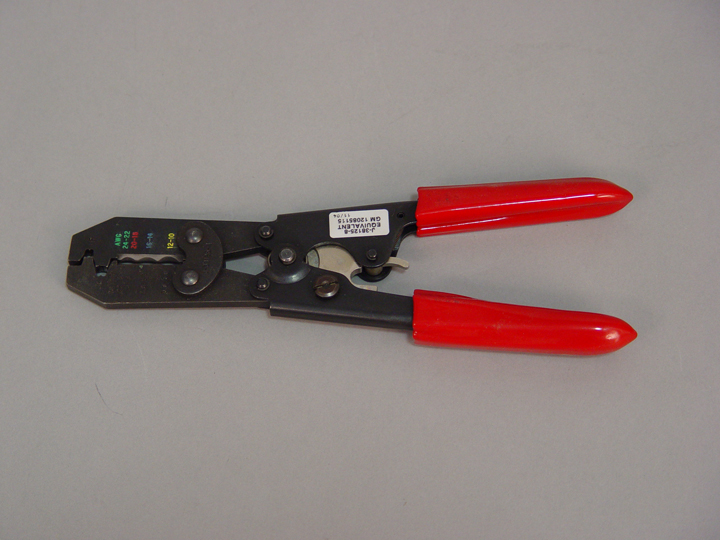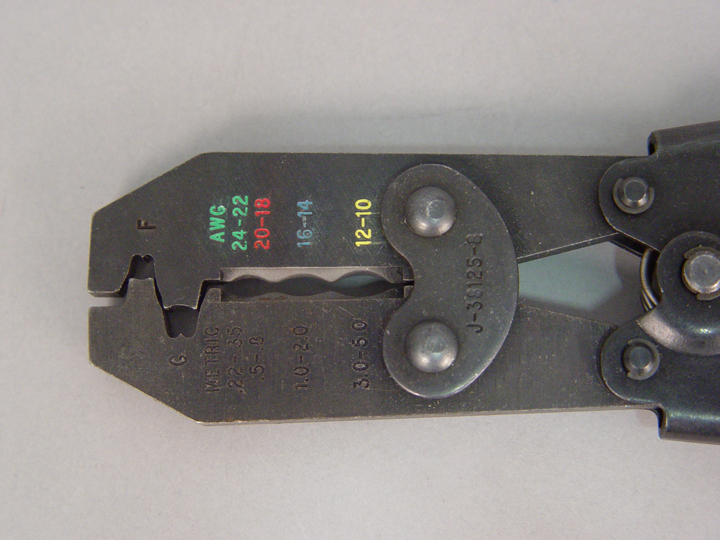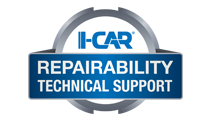Restraints System Wiring Repairs
 Figure 1 - These crimp and seal splice sleeves have special heat shrink sleeves on each end that shrink around the wire and form an air-tight seal.Confusion exists within the collision industry concerning the repair of some damaged wiring and wiring connectors for restraints systems. The perception is that restraints system wiring should never be repaired. While it is true that some vehicle makers do not recommend the repair of wiring and connectors for the restraints system, others have very detailed printed procedures and even offer repair kits expressly for the repair of restraints system wiring. Repairing damaged restraints system wiring, when applicable and the parts and procedures are available, can save unnecessary replacement of the main body and instrument panel wiring harnesses.
Figure 1 - These crimp and seal splice sleeves have special heat shrink sleeves on each end that shrink around the wire and form an air-tight seal.Confusion exists within the collision industry concerning the repair of some damaged wiring and wiring connectors for restraints systems. The perception is that restraints system wiring should never be repaired. While it is true that some vehicle makers do not recommend the repair of wiring and connectors for the restraints system, others have very detailed printed procedures and even offer repair kits expressly for the repair of restraints system wiring. Repairing damaged restraints system wiring, when applicable and the parts and procedures are available, can save unnecessary replacement of the main body and instrument panel wiring harnesses.
As an example, this article will focus on the repair of restraint system wiring on General Motors (GM) vehicles. Whenever doing restraint system wiring repairs, always follow the procedures and use the parts and equipment specified by the vehicle maker for the vehicle being repaired. This information can be found typically in the “BODY” section of the service information under “WIRING REPAIR” for GM vehicles.
Self Diagnostics
Let’s begin with some background on how the self-diagnostic capabilities of modern restraint systems function. When a problem exists in the electrical circuit of a restraint system, a diagnostic trouble code (DTC) is stored in the restraint system control module and a malfunction indicator lamp (MIL), or airbag warning lamp, on the instrument panel is turned on to alert the driver. The computer is able to detect problems by monitoring system voltage, amperage, and resistance readings, and comparing them to specified values. If a monitored value falls outside the programmed parameters, a DTC is set and the MIL is turned on. Wiring repairs done improperly can increase the resistance in a circuit to the point that the control module senses a fault and sets a DTC. Repairs that do not completely seal the splice joint from moisture can allow corrosion of the connection. This corrosion will also increase circuit resistance and eventually lead to a DTC and MIL.
Restraint System Requirements
What makes a restraint system wiring repair different from any other wiring repair? While there are a couple of recommendations that may be specific to restraint systems, the reality is that restraint system wiring repair demands the same best practices that should be observed with any other wiring repair. The first, and maybe only real difference, is that while GM recommends repairs rather than the replacement of a wiring harness, short pigtails that are attached to parts such as sensors and inflator modules are not repairable. If a pigtail connected to a part is damaged, the part should be replaced.
Restraint system wiring repairs vary from a simple splice of a cleanly cut wire or replacement of sections of damaged wire, to replacement of terminals or even entire connectors. All of these operations may involve splicing wires together.
Splice Sleeves
To help address the issue of making low resistance and moisture-proof, or air-tight splices, special “DuraSeal” crimp and seal splice sleeves were designed (see Figure 1). These connectors differ from the conventional butt connectors in a couple of important ways. First, they have a special cross-hatched (knurled) core crimp barrel that provides the necessary contact integrity to make a low resistance splice. Secondly, they have a special heat shrink sleeve that contains a sealing adhesive inside. When the connectors are heated, they shrink over the wire and make an air-tight seal that protects the connection from the environment. Although these connectors were initially designed for repairing restraint system wiring, because of their superior performance, they are now the recommended splice by GM for all wiring repairs. The only limitation these connectors have is that they can only be used to splice two wires together. For repairs to original equipment splices of three or more wires, special splice clips are available from GM. These types of connections are typically limited to grounds and their application to restraint system wiring is not common. The splice clips have detailed instructions included for applications and usage.
The splice sleeves are available in different sizes and are color coded. Green colored splices (88988379) are used for 22-24 gauge, salmon (#12089189) for 18-20 gauge, blue (12089190) for 14-16 gauge, and yellow (12089191) for 10-12 gauge. To ensure circuit integrity the correct splice sleeve for the wire size must be used.
 Figure 2 - This special splice-crimping tool is designed to work with the crimp and seal splice sleeves, and ensures that the insulation tubing is not damaged.The tools and procedures used when making wire splices is as important as the type of splice connector. If the crimping tool used on the connector damages the insulation tubing over the metal core crimp barrel, the connection may not be sealed sufficiently from moisture resulting in corrosion. Because of this, GM recommends a special splice crimping tool (J-38125-8, GM P/N 12085115) be used (see Figure 2). The crimping tool has three nest positions. Position 1 is used for 18-24 gauge wire, or the green and salmon colored splice sleeves. Position 2 is for 14-16 gauge wire, or the blue splice sleeves, and position 3 is for 10-12 gauge wire, or the yellow splice sleeves. The nest positions on the crimp tool are color-coded for easy reference (see Figure 3). The crimping tool also has a locking ratchet mechanism in the handle that keeps the tool from being reopened until the proper amount of pressure has been applied to the splice sleeve. After the splice sleeve has been put into the proper nest, and the wire inserted into the metal core crimp, the handles on the crimping tool are closed and squeezed until they open when released. This ensures that just the right amount of pressure is applied to the splice sleeve.
Figure 2 - This special splice-crimping tool is designed to work with the crimp and seal splice sleeves, and ensures that the insulation tubing is not damaged.The tools and procedures used when making wire splices is as important as the type of splice connector. If the crimping tool used on the connector damages the insulation tubing over the metal core crimp barrel, the connection may not be sealed sufficiently from moisture resulting in corrosion. Because of this, GM recommends a special splice crimping tool (J-38125-8, GM P/N 12085115) be used (see Figure 2). The crimping tool has three nest positions. Position 1 is used for 18-24 gauge wire, or the green and salmon colored splice sleeves. Position 2 is for 14-16 gauge wire, or the blue splice sleeves, and position 3 is for 10-12 gauge wire, or the yellow splice sleeves. The nest positions on the crimp tool are color-coded for easy reference (see Figure 3). The crimping tool also has a locking ratchet mechanism in the handle that keeps the tool from being reopened until the proper amount of pressure has been applied to the splice sleeve. After the splice sleeve has been put into the proper nest, and the wire inserted into the metal core crimp, the handles on the crimping tool are closed and squeezed until they open when released. This ensures that just the right amount of pressure is applied to the splice sleeve.
 Figure 3 - The splice-crimping tool used to install the crimp and seal splice sleeves has color-coded nest positions to ensure that the correct nest position is used for the application.To repair damage to GM restraint system wiring, follow this procedure in the order listed (see Video).
Figure 3 - The splice-crimping tool used to install the crimp and seal splice sleeves has color-coded nest positions to ensure that the correct nest position is used for the application.To repair damage to GM restraint system wiring, follow this procedure in the order listed (see Video).
- Open the wiring harness by removing any tape. Do not damage the wiring insulation when cutting the harness open. A sewing ripper works well for this.
- Cut as little wire off the harness as possible. Damaged sections of wire must be removed and other sections may need to be cut away to change the locations of splices. Splices should be located at least 40 mm (1.5 in) away from harness branches, connectors, or other splices.
- Strip the insulation from the splice locations. You must obtain a clean strip with all of the wire strands intact. If you are unsure of the wire size, and have no way to accurately measure it, begin with the largest opening on the wire stripper and work down until a clean strip of the insulation is achieved. Strip about 7.5 mm (5/16 in) of insulation from each wire to be spliced. After stripping the wire, inspect the wire strands for nicks or cut strands. If any damage is found to the wire, cut the damaged portion off and repeat the stripping procedure.
- Select the proper size splice sleeve for the wire size.
- Obtain the correct splice crimp tool to crimp the splice sleeve.
- Place the splice sleeve in the correct nest of the crimping tool. Ensure that the crimp made falls midway between the end of the metal crimp barrel and the wire stop. The wire stop is in the center of the barrel (see Figure 4). Close the crimping tool handles slightly in order to firmly hold the splice sleeve in the crimp tool nest.
- Insert the wire into the splice sleeve barrel until the wire hits the stop.
- Tightly close the crimping tool handles until they open when released.
- Repeat steps 6-8 for the opposite end of the splice sleeve.
- Using a heat torch (J-38125-5 or equivalent), apply heat to the crimped area of the barrel. Gradually move the heat to the open end of the splice sleeve tubing. The shrink tubing will shrink down tightly against the wire as the heat is applied, and a small amount of sealant will come out of the open end of the tubing. The heat torch used should have a heating barrel to distribute the heat evenly around the entire splice sleeve (see Figure 5).
Video–This video shows the order of repairs to GM restraint system wiring.
Replacing Wiring Harness Parts
Damaged connector terminals present other considerations. The terminals are gold plated to ensure the contact integrity of the sensitive low energy restraint system circuit. Damaged terminals in the sensing and diagnostic module (SDM) harness connector can be replaced, but must only be replaced with the terminated leads in the SIR/SRS connector repair assembly pack. Do not substitute any other terminals for those in the SIR/SRS assembly packs. These terminals are crimped onto short sections of wire that can be spliced into the harness with the splice sleeves after they are inserted into the connector body. Damaged terminals in other restraint system connectors are repaired by splicing a new connector assembly into the wiring harness. The wiring harness side connectors are available as service parts.
When sections of wire require replacement, ensure that the wire used is the same wire size and type as that being replaced. Other parts that are available for restraint system wiring repairs include connector position assurance (CPA) inserts and terminal position assurance (TPA) inserts (see Figure 6). The CPAs are inserted through locking tabs on the connectors to ensure that the connector halves cannot vibrate apart, and the TPAs keep the terminal pins seated securely in the connector body. Both of these inserts must be undamaged and in place to ensure good contact between the mating terminals of the connection.
All of these parts are available separately or in an SIR Repair Kit tray. The SIR tray is a part of a bigger Terminal Repair Kit (J-38125) that includes all the tools, connectors, splice sleeves, and other parts to repair any part of a damaged wiring harness. Also included in the SIR Repair Kit tray is shrink tubing that is used to cover splices and protect them from heat in areas where they are exposed to high temperatures. Yellow electrical tape is supplied so that color coding of the wiring can be maintained for splices made in areas that have color-coded wiring.
Conclusion
Restraint system wiring repairs are allowed by several vehicle makers, including GM. While not difficult, always follow the vehicle maker’s recommendations as to the parts and procedures used. This will ensure that the integrity of the system is maintained and that repairs will have the durability necessary to maintain proper system functioning.
This article first appeared in the October 31, 2005 edition of the I-CAR Advantage Online.
Additional I-CAR Collision Repair News you may find helpful:
Related I-CAR Courses
Article validated in 2024
-
Toyota/Lexus/Scion Position Statement: Pre- and Post-Repair System Scanning
Thursday, 28 July 2016
As the industry continues to ask if pre- and post-repair system scanning is necessary, Toyota/Lexus/Scion provides their answer.
-
Pre- and Post-Repair System Scanning Statements
Wednesday, 9 January 2019
Are you wondering if a particular OEM or organization has a published statement on pre-repair and post-repair scanning? We have compiled a list of most of the statements on the subject, so you can...
-
ADAS, Calibration, And Scanning Article Hotspot
Monday, 14 January 2019
Since advanced driver assistance systems (ADAS), scanning, and calibration first started becoming relevant, members of the collision repair industry have required as much knowledge as possible on...
-
Honda/Acura Position Statement: Pre- and Post-Repair System Scanning - UPDATE
Wednesday, 22 May 2019
Honda /Acura has updated their position statement on pre- and post-repair scanning to give more clarification on what is expected for scanning.
-
BMW Position Statement: Pre- and Post-Repair System Scanning - UPDATE
Friday, 10 April 2020
BMW has released a position statement related to pre- and post-repair system scanning. The statement applies to All vehicles equipped with on board diagnostics II (OBD II).
-
Quickly Identifying Outer Quarter Panels w/Rolled Hem Flanges
Monday, 5 March 2018
The I-CAR best practice article, Recycled Outer Quarter Panels w/Rolled Hem Flanges has gotten a lot of interest from the collision repair industry. It’s important to know which vehicles are...
-
General Motors Position Statement: Pre- and Post-Repair System Scanning
Friday, 21 October 2016
As the industry continues to ask, are pre- and post-repair scans necessary, General Motors provides their answer.
-
Restraints Wiring Repairs
Monday, 23 May 2016
Over the past few months, we've been sharing OEM position statements on restraints wiring repairs. Now we're bringing them all together in one place for easy reference.
-
FCA/Stellantis Position Statement: Pre- and Post-Repair System Scanning
Thursday, 9 June 2016
FCA/Stellantis has released a position statement related to pre- and post-repair system scanning.
-
Typical Calibration Requirements For Forward Radar Sensors
Wednesday, 12 October 2016
Technicians should be aware of what’s required to keep advanced driver assistance systems (ADAS) running safely after a collision. Whether that be aiming a camera, which can cause a system to not...
-
Body Repair Manual Symbols: Hyundai
Wednesday, 17 December 2025
While looking at repair procedures in a body repair manual (BRM) you may notice that symbols are used to indicate specific operations or parts to be used during the repair process. Most BRMs provide a...
-
Body Repair Manual Symbols: Genesis
Wednesday, 17 December 2025
While looking at repair procedures in a body repair manual (BRM) you may notice that symbols are used to indicate specific operations or parts to be used during the repair process. Most BRMs provide a...
-
App-Based Connected Services Considerations: BMW
Wednesday, 10 December 2025
Have you had an experience where the vehicle notified the owner that it was being moved while it was in your repair facility? App-based connected services are available from many vehicle makers and...
-
Digital Key Considerations: BMW
Wednesday, 10 December 2025
The intermingling of technology and automobiles continues, with digital key offerings from most vehicle makers. Digital keys utilize smartphone technology to expand vehicle access and owner...
-
I-CAR Repairers Realm: RTS 2025 Year In Review - Coming Soon
Tuesday, 9 December 2025
I-CAR is having a discussion on the Repairability Technical Support (RTS) 2025 year in review.
-
Mercedes-Benz Vehicles On The RTS OEM Calibration Requirements Search
Thursday, 4 December 2025
Mercedes-Benz models are now listed in the OEM Calibration Requirements Search page on the RTS website. You're going to notice a difference between other vehicle search results and Mercedes-Benz...
-
I-CAR Repairers Realm - New In 2026: Mixed Attachment Methods And Steel Sectioning Recertification - Now Available
Monday, 1 December 2025
I-CAR had a discussion on the new Mixed Attachment Methods course launching in 2026.
-
Repairer Driven News: SCRS OEM Collision Repair Technology Summit Sessions
Monday, 1 December 2025
Repairer Driven News published three articles highlighting safety inspection topics that took place during the Collision Repair Specialists (SCRS) OEM Collision Repair Technology Summit at the 2025...
-
I-CAR Audi Collision Repair And Electromechanical Repair Overview Courses
Tuesday, 25 November 2025
I-CAR has developed courses that provide an overview of collision repair and electromechanical repair for current Audi vehicles.
-
SEMA 2025: Ford/Lincoln Presentations
Monday, 24 November 2025
I-CAR had numerous presentations at the 2025 SEMA show. Ford/Lincoln delivered two presentations.
- 2025
- December 2025 (8)
- November 2025 (11)
- October 2025 (13)
- September 2025 (11)
- August 2025 (12)
- July 2025 (11)
- June 2025 (11)
- May 2025 (11)
- April 2025 (13)
- March 2025 (12)
- February 2025 (11)
- January 2025 (12)
- 2024
- December 2024 (8)
- November 2024 (10)
- October 2024 (13)
- September 2024 (10)
- August 2024 (12)
- July 2024 (11)
- June 2024 (9)
- May 2024 (13)
- April 2024 (12)
- March 2024 (12)
- February 2024 (12)
- January 2024 (9)
- 2023
- December 2023 (8)
- November 2023 (12)
- October 2023 (11)
- September 2023 (11)
- August 2023 (12)
- July 2023 (9)
- June 2023 (11)
- May 2023 (12)
- April 2023 (11)
- March 2023 (12)
- February 2023 (10)
- January 2023 (11)
- 2022
- December 2022 (11)
- November 2022 (12)
- October 2022 (11)
- September 2022 (13)
- August 2022 (11)
- July 2022 (10)
- June 2022 (13)
- May 2022 (11)
- April 2022 (12)
- March 2022 (10)
- February 2022 (11)
- January 2022 (13)
- 2021
- December 2021 (13)
- November 2021 (11)
- October 2021 (13)
- September 2021 (14)
- August 2021 (12)
- July 2021 (15)
- June 2021 (17)
- May 2021 (11)
- April 2021 (14)
- March 2021 (20)
- February 2021 (14)
- January 2021 (14)
- 2020
- December 2020 (13)
- November 2020 (17)
- October 2020 (12)
- September 2020 (14)
- August 2020 (11)
- July 2020 (18)
- June 2020 (14)
- May 2020 (14)
- April 2020 (19)
- March 2020 (12)
- February 2020 (13)
- January 2020 (14)
- 2019
- December 2019 (13)
- November 2019 (19)
- October 2019 (25)
- September 2019 (20)
- August 2019 (22)
- July 2019 (23)
- June 2019 (20)
- May 2019 (19)
- April 2019 (20)
- March 2019 (20)
- February 2019 (18)
- January 2019 (17)
- 2018
- December 2018 (18)
- November 2018 (19)
- October 2018 (17)
- September 2018 (16)
- August 2018 (21)
- July 2018 (20)
- June 2018 (21)
- May 2018 (17)
- April 2018 (19)
- March 2018 (21)
- February 2018 (15)
- January 2018 (20)
- 2017
- December 2017 (13)
- November 2017 (15)
- October 2017 (19)
- September 2017 (20)
- August 2017 (19)
- July 2017 (18)
- June 2017 (19)
- May 2017 (19)
- April 2017 (13)
- March 2017 (18)
- February 2017 (10)
- January 2017 (11)
- 2016
- December 2016 (9)
- November 2016 (14)
- October 2016 (21)
- September 2016 (10)
- August 2016 (11)
- July 2016 (8)
- June 2016 (10)
- May 2016 (5)
- April 2016 (11)
- March 2016 (12)
- February 2016 (10)
- January 2016 (8)
- 2015
- December 2015 (9)
- November 2015 (6)
- October 2015 (8)
- September 2015 (7)
- August 2015 (11)
- July 2015 (7)
- June 2015 (5)
- May 2015 (7)
- April 2015 (8)
- March 2015 (8)
- February 2015 (9)
- January 2015 (10)
- 2014
- December 2014 (12)
- November 2014 (7)
- October 2014 (11)
- September 2014 (10)
- August 2014 (9)
- July 2014 (12)
- June 2014 (9)
- May 2014 (12)
- April 2014 (9)
- March 2014 (6)
- February 2014 (1)
- January 2014 (26)










